Shading is about giving definition, form, tonal value, contrast, depth, three-dimensions… all of which really surmount to the same thing (though putting aside the discussion of edges, which is dealt with elsewhere). The quality and effect of shading is dependent on the type of pencil you are using, the paper’s surface, as well as the pressure and technique used.
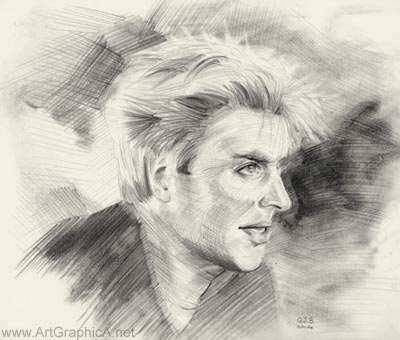
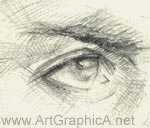
Cross Hatching
The beauty of cross-hatching is that once learnt, it is fast, and if used to follow the contours and direction of the subject being depicted, it further adds definition to that form.The density of the lines (i.e. the spacing between them) determine depth, and further depth and definition of form can be rendered with subsequent layers of cross-hatching.
If so desired the hatching can always be blended and smoothed out with a tissue or blending stump.
Stippling
Stippling involves creating depth through the placement of many dots, with a continued dabbing motion of the hand. It is a useful technique for pen drawing where only one tone is available, but can also find a role in all other mediums.
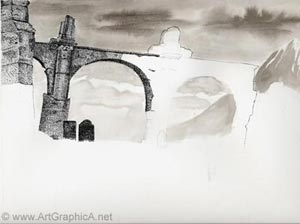
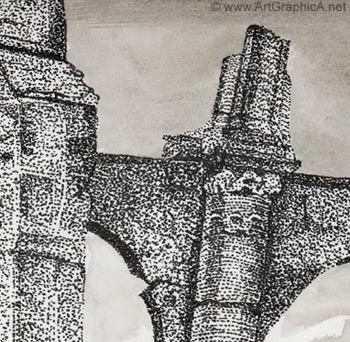
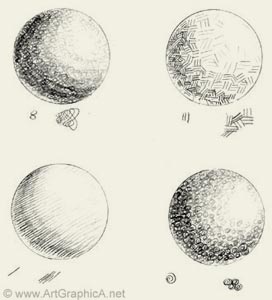 Textural Effects
Textural Effects
Sky, water, grass, skies, metal, plastic, fur, foliage… all possess different texture – smooth, rough, dark, light, reflective, matt.
Experimenting with different motions of the pencil yields more variety and interest to elements within a drawing. Try inventing some different shapes and squiggles, and you might discover some useful tricks that can be used in your drawings.
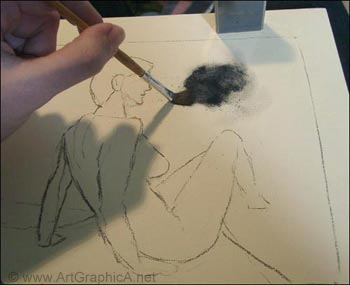
Dust and Brush
Graphite or charcoal can be ground down into a fine powder and applied with a brush… Usually the results are quite soft and light, and to deepen the contrast, it can be useful to spray a little fixative onto each layer to give cohesion for subsequent layers.
Water Soluble Pencils
It is possible to buy pencils that function as traditional graphite drawing implements, but accept water and a brush, allowing a soft even wash effect to be applied. It is advisable to work on certain heavy-weight or watercolour papers.
Watercolour pencils are also available and can be used in a similar fashion.

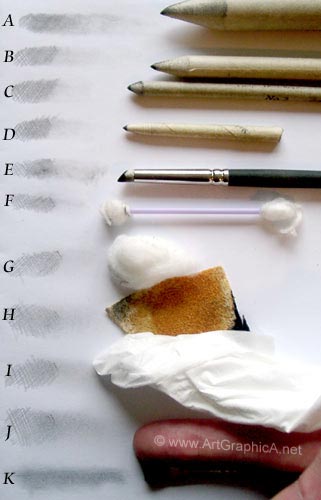
Shading Techniques
- A - Blending Stump (large)
- B - Blending Stump (medium)
- C - Blending Stump (small)
- D - Tortillion
- E - Colour Shaper
- F - Cotton Wool Bud
- G - Cotton Wool
- H - Chamois Leather
- I - Tissue
- J - Finger
- K - Brush (hidden in finger shadow!)
Anything that doesn't damage the surface of the paper can be used to blend, and you will need to experiment to find what works best for your own needs.
I would urge caution on the use of a finger - good as it may be, it does leave oils on the paper surface. Using a brush to blend is only really successful with ground graphite dust or charcoal powder.
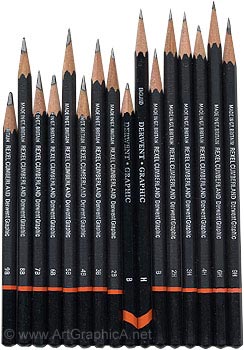
Hard Pencil Over Soft
When using a full range of pencils the B ranges can appear grainy, as the graphite dissipates more than an H. Some artists solve this problem by applying a higher H grade pencil over the shaded area, the harder pencil acts as a type of blender.
Pressure vs. Layering
Darker tones can be applied by using a different grade of pencil, but there is also a choice in whether to press harder and achieve the darker contrasts in one go, or building them up several layers at a time. The former is faster, and more applicable to sketching, the latter more time consuming, but allows for a greater degree of control. In recent times the mechanical pencil is quite a popular choice not only because it keeps a sharp edge, but because it is possible to build a wide range of contrasts through layering. In this respect a conventional pencil is often a better sketching tool, if you sharpen it correctly you can use the edge of the pencil to block in large areas in one go.
A BRIEF LOOK AT SHADING AND BLENDING IN OTHER MEDIUMS
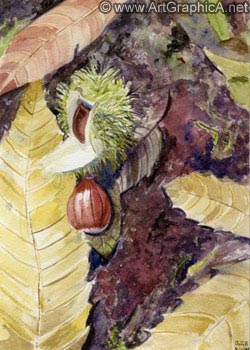
Watercolours
Light is created through the white of the paper, and so tone and depth can only be created through using more pigment and less water.
Like graphite, darker tones can be achieved in one go with a more concentrated paint solution, or it can be layered (also referred to as glazing – when working in colour, glazing can also modify hues). The quality of the paper determines the number of layers that can be applied.
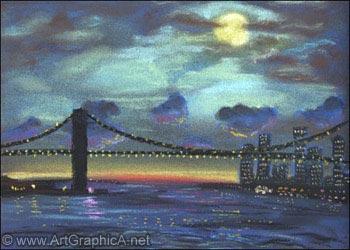
Charcoal/Pastel
Again, pressure can determine depth of tone, though layering is an alternative option. Because charcoal particles do not adhere so readily to paper compared to say graphite, it is sometimes necessary to spray a layer of fixative before proceeding. Pastels work in a very similar fashion.
Blending is extremely easy, and it can be easy to over blend. Please note that a number of pastels are toxic and can be absorbed by the skin. The same caution is applicable to oil paints - particularly cadmium colours.
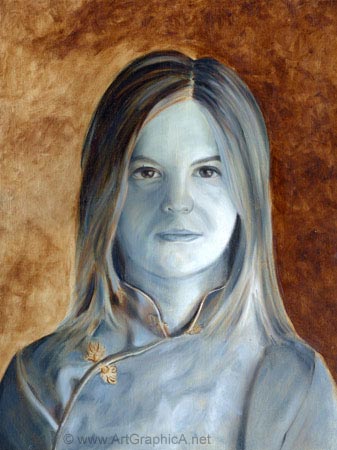
Oils
Oils can be painted Alla Prima (wet-into-wet – usually done in one sitting), or left to dry and then layered (aka glazed). Oil paints can be applied opaquely and transparently and so a layered approach can add depth not achievable through any other method – the Flemish and Renaissance masters used it to great effect. Oils are most effectively blended with soft sable brushes, and brush marks can be removed altogether using something like a badger brush. The opaque nature of oils means they can be lightened by mixing colours with lighter pigments.
The painting on the right is in the unfinished underpainting stages, waiting for some colour glazes.
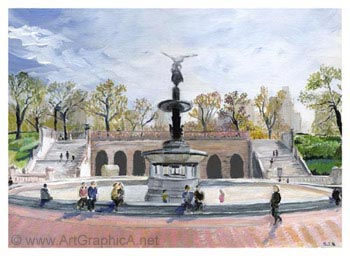
Acrylics
Acrylics seem to lie somewhere between oils and watercolours, and can be mixed with water and used transparently like a watercolour painting, or they can be applied opaquely like oils. Blending techniques are difficult to achieve due to the very fast drying rate of acrylics, but layering can change the tone and/or colour, and can also be used to blend.
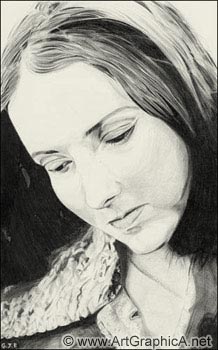
Ballpoint Pen
A ballpoint pen can be used as a conventional drawing pen, using such techniques as stippling, but unlike other pens, it is capable of producing a half-tone through lighter pressure. I have only tried drawing with it once, but use it often for sketching.
Tutorial is copyright of ArtGraphica